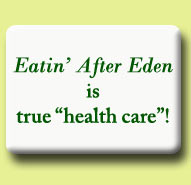HOW IS EATIN' AFTER EDEN DIFFERENTFROM OTHER HEALTH & WELLNESS BOOKS?
"This is crazy!" the reader of Eatin' After Eden said to his friend Ellen. Yet Larry couldn't put down the riveting book.. When he had complained about the diet his nutritionist had him on, Ellen had suggested Eatin' After Eden and gave Larry a copy. "It won't hurt you to read it," she said. For one who had never known anything but a vegan diet, the thought of eating red meat and certain saturated fat was mindboggling. When Larry again exclaimed, "It's just crazy!" Ellen responded enthusiastically, "It works!" and grinned.
Why Do We Need Something Different, Something More?
Yes, this book is different from the rest though some others also include the Good News.
... vegetarianism and veganism (as well as another entitled "Why Not Soy?"). Extensively documented with scriptural principles, facts of solid nutrition science, the history of these diets, and lists of many nutritional deficiencies associated with them, the alarming consequences of rejecting God's plan for eating are spelled out.
The Flawed Lipid Theory
Some other diet books also include a great deal of information regarding the lipid hypothesis, “The greatest health scam of the century,” according to internationally known and highly esteemed Dr. George V. Mann. The lipid theory has duped the world into accepting that “Saturated fat increases blood cholesterol, which causes arterial fatty plaque, leading to atherosclerosis, heart disease, and myocardial infarction [heart attack from a clot obstructing a coronary artery].” There are fifty pages in this book about this theory and the truth about cholesterol. (Fifty percent of patients undergoing this surgery don’t have high cholesterol.)
Beyond Nutrition 101
Many health and wellness books teach Nutrition 101 (with today's conventional spin on it). Eatin’ After Eden focuses upon the Creator’s unique nutrition plan mercifully bestowed upon man after the Fall, after Eden. His program relies on nutrient-dense, highest quality animal-source foods for the underlying foundation of our diets. That quality protein with its essential fat is indispensible in God’s diet. This book has a chapter explaining simply but scientifically why this must be first in the diet. (Quality protein is converted for energy, but carbohydrates cannot be converted to protein.) The reader learns about all the healthy fats as well as what is wrong with the much touted fabricated ones. In the Creator's comprehensive nutrition, plant foods are included for vitamins, minerals, trace minerals, and phytonutrients.
Fabulous Footnotes - A Huge Extra Convenience For Readers
Have you ever been frustrated with being forced to flip to the back of the book for endnotes? For the careful reader Eatin’ After Eden supplies hundreds of unusual manually indented footnotes (not end notes) for easy reading. The book is extremely well documented with persuasive studies simplified and reported in interesting presentations together with other useful referenced evidence.
Food Enhancing Proper Preparation
Food preparation is very important. Loss of nutrients and avoidance of toxins is avoided by using whole (organic) foods, and keeping meal preparation simpler and shorter, yet satisfying taste buds Americans have retrained with 75 years of commercialized foods. With the sample recipes at this Website readers are also taught how to quickly and easily convert thousands of recipes of their choosing while retaining their tasty preferences.
What Eatin' After Eden Is Not
This book is not a sales aid pitched to promote certain products. Eatin’ After Eden was written with one aim. “My people are destroyed for lack of knowledge…Do the most for the most,” the Holy Spirit instructed its author. It provides restoring, healing knowledge you can use to support your body’s profound efforts to increase and maintain its level of wellness for His work until He comes again.
Here is a powerful extra for no charge:
5 WAYS TO AVOID GMO FOODS1
Probably you have heard of GMOs and are at least somewhat concerned. Genetic modification (GM), more correctly genetic engineering (GE) of foods, actually has to do with splicing so as to artificially insert genes into the DNA of food plants and animals. Such genetically modified organisms (GMO) involve genes from bacteria, insects, animals, viruses, and would you believe, even from humans. While most Americans know little about GE, they know they don't want this kind of tampering with their foods. They also say they would not knowingly eat foods labeled GMOs; yet labeling is legally optional in America. What are we to do to avoid these foods? There are some important, simple steps you can take to very significantly reduce the chances that your food is genetically engineered. Here are five...1. BUY ORGANIC
Certified organically grown foods cannot legally contain GMOs.
2. BUY FRESH, WHOLE FOODS
Limit purchases of packaged foods. Of course organic, extra virgin olive oil, virgin coconut oil, sea salt, butter, yeast for baking bread, raw apple cider vinegar, and the like must be packaged. But be aware that only 70% of ingredients are required by law to be organic in products labeled "made with organic ingredients." If you purchase a packaged product make sure each ingredient is listed individually as organic; otherwise they are not. Some organic products may list many ingredients with one or two not shown as organic that may be GMO. If a non-organic packaged product has a list of ingredients, you can likely count on at least one of the ingredients being GE. Be aware also that there are countless hidden GMOs in processed foods not certified organic or labeled non-GMO. Again, it is best to consume certified organic, fresh, whole foods as they were created and designed for our bodies for maximum utilization. Best is to grow as much as possible in your own organic garden, flower bed, or containers.
3. "THE BIG 4"
Most processed, fabricated foods (packaged) contain corn, soy, canola, or cottonseed oil, or ingredients made from The Big 4. (Many nutritional supplements contain non-organic soy oil.) Look for corn oil and corn syrup; modified corn starch, and sugars dextrose, fructose, and glucose.2 Soy products may contain soy lecithin, isoflavones, oil, protein, and isolates. Canola oil may sometimes be labeled as rapeseed oil.
4. CHECK PLU STICKERS AND LABELS ON FRUITS AND VEGETABLES
Stickers and labels on fruit and some vegetables can be difficult to remove. A paring knife gently slipped under the plastic labels with the side of your thumb on top of the label and overlapping the knife, then lifted gently so as not to tear the peel away before a brief soak in grapefruit seed extract water solution and rinse, works well. The stickers are not there just for the grocers' convenience at the cash register. Before you get home from the store, and even before you make the selection, be sure and take advantage of the very valuable information on the stickers. They can tell you if the fruit is genetically engineered, if it was organically grown in nourishing, naturally fertilized soils with none of the harmful toxins, or if it was subjected to soil-depleting chemical fertilizers, fungicides, or herbicides. Here's how to read the stickers for the helpful details:
Four numbers in the PLU informs us that the fruit or vegetable was grown conventionally with pesticide applications, etc..
Five numbers in the code with a beginning number of 8 alerts us that this is a GMO fruit or vegetable.
Five numbers beginning with 9 in the PLU code is what we are looking for – assurance that the food is organic, and is not GE.
Most fresh produce is not GMO, or is fruit awaiting government approval of a GMO. However, just because a food is not GMO doesn't mean it is the best to consume. Consider also pesticides and other toxic sprays, especially if you care about your liver, or your children. If your health is not a top priority and you do not eat organic, you may be interested to know that two of the most nutritious fruits are kiwis and avocados, neither of which requires much spraying. (See Why Go Organic?" at this website.)
5. AVOID SUGAR
At least 50 percent of white sugar sold in the US comes from sugar beets. If you consume this very health-damaging substance, you can be fairly certain that unless the package clearly states it is certified organic or "100 percent cane sugar," it comes from GMO crops since 95% of US sugar beets are Monsanto GMO. However, GE is only part of this frightening picture---Nancy Appleton, PhD (UCLA) found 150 different diseases linked to sugar of various kinds. For the list, see our book, Eatin' After Eden. (Dr. Appleton's book, Lick the Sugar Habit, is available from this website through eatin_after_eden@wvi.com.)
A word of caution: A couple of years ago we visited a local farmer's market where a young grower first told us her eggs were organic, "all natural," from pastured hens, eating nothing else but grass, bugs and worms. When it was mentioned that hens do not lay regularly without supplementing such as non-organic grain, laying mash, corn, or soy (the minimum sale to these farmers of such feeds may be a ton, and the cost is prohibitive), the farmer confessed that indeed the eggs were not organic. We have since found a knowledgeable farmer who uses other organic supplemental feeding but it's important to know your source since otherwise the non-grass feeds likely are not organic. To Your Health has a wide variety of grains for humans that are certified organic; and sprouted with proof of assay to contain low phytates, including non-gluten oats.
EACH OF THE 11+ CHAPTERS IN EATIN' AFTER EDEN IS A STAND-ALONE-BOOK IN ITSELF—ALL FOR THE PRICE OF ONE! WHEN THE CHAPTERS ARE READ TOGETHER THERE IS A SYNERGISTIC EFFECT THAT CAN EXPONENTIALLY ENHANCE YOUR ACHIEVEMENT OF AN ADVANCED LEVEL OF WELLNESS.




